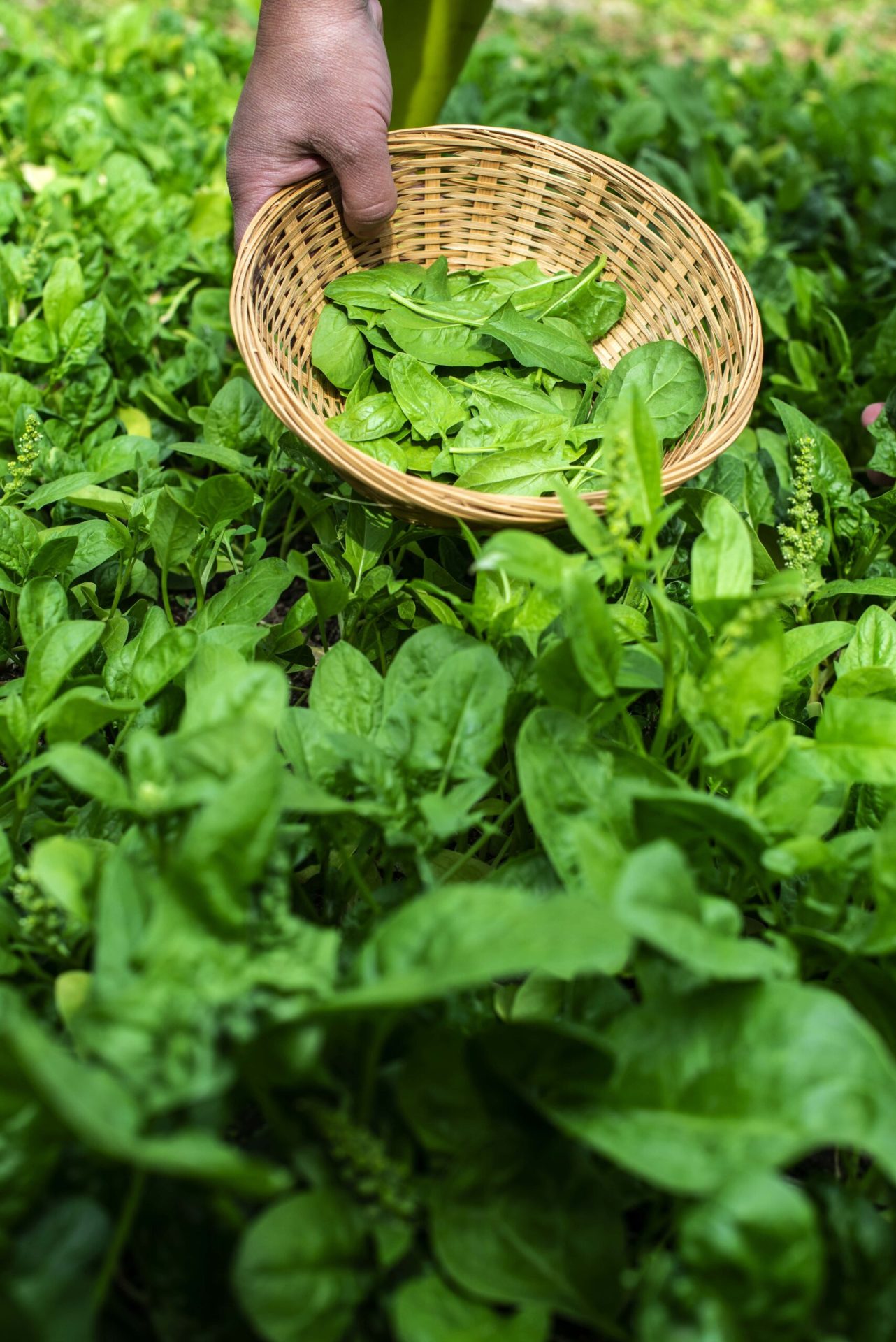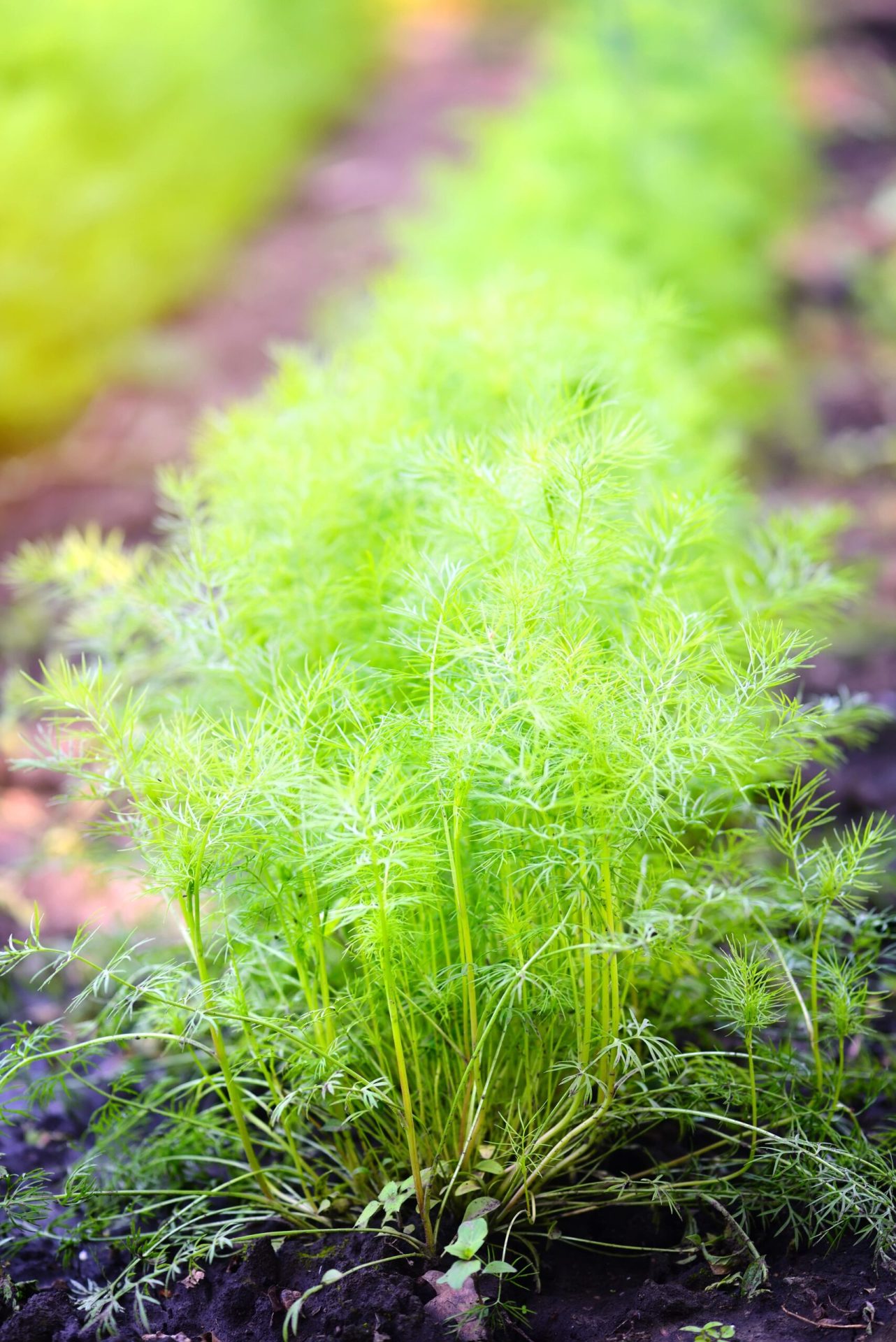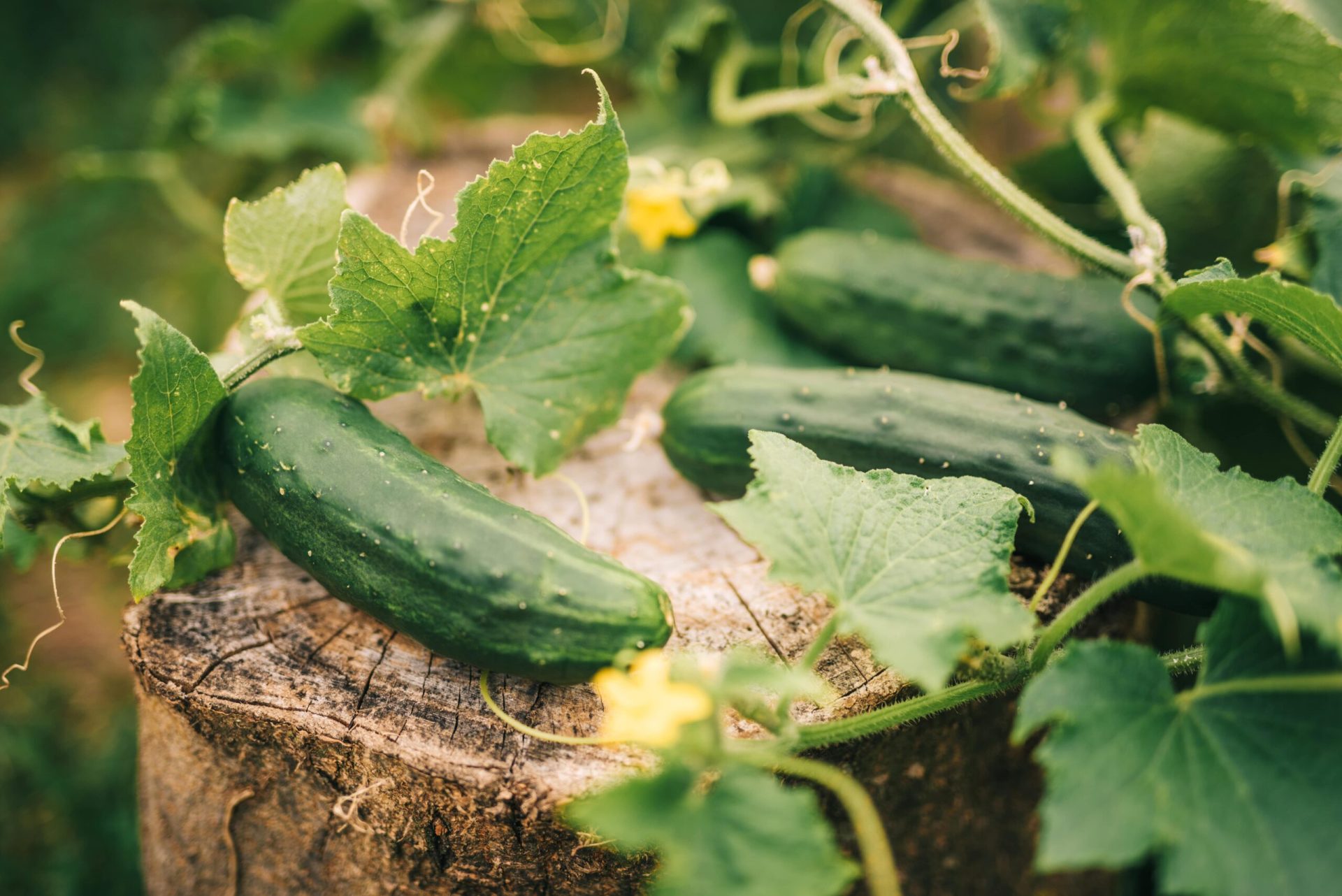Spinach is a cool-season green leafy vegetable, and it’s typically one of the first in the garden in spring. In terms of health benefits, fresh-grown spinach is a superfood, and when freshly picked, delivers tons of flavor and texture.
Fortunately, growing spinach in your home garden is easy. Keep reading for some help. Our spinach growing guide covers spinach growing stages, varieties, storage, harvesting tips, and more.
Growing Spinach 101: Step-by-Step Guide
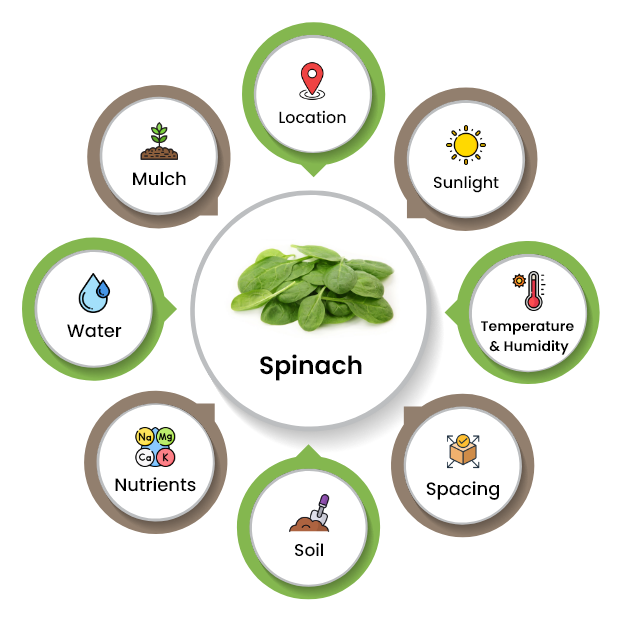
1. Location
Select a spot with morning sun and afternoon shade (in spring and summer), which protects tender spinach plants from peak heat.
2. Temperature & Humidity
Spinach is a cool-season crop. It thrives well in the cooler temperatures of fall and spring (with ranges from 50°-60°F and 45-55% humidity).
3. Spacing
Leave at least four to six inches of space between plants to help spinach develop properly.
4. Soil
Well-draining soil, rich in organic matter and with a pH of 6.5-7, is ideal for spinach.
5. Nutrients
Calcium and magnesium are the most essential nutrients required for growing spinach.
6. Water
Spinach requires about 1 to ½ inches of water per week. In spring, rainfall may suffice.
7. Mulch
A 2-inch layer of organic mulch, like pine bark, straw, or shredded leaves, helps keep the soil cool and moist.
How to Grow Spinach from Seeds?
- Make a shallow hole in well-prepared and fertile soil in a sunny location.
- Sow spinach seeds thinly, approximately a half-inch deep.
- Cover seeds with a soil layer and water them well.
- Sow in rows about 15 inches apart.
- Use row covers to maintain cool soil and deter pests.
- Sow a new batch every three to four weeks to get a regular supply of spinach through the growing season.
How to Grow Spinach in Containers?
Spinach has a deep taproot. You will need a container of at least eight to ten inches wide and deep.
- Ensure the container has proper drainage holes.
- Use well-draining soil that’s mixed with organic matter or compost to provide essential nutrients.
- Sow seeds directly in the container.
- Space seeds about 1 inch apart and cover them lightly with a layer of soil.
- Press gently to ensure good seed-to-soil contact.
- Keep the soil consistently moist.
- Place the container in a location that receives at least 6-8 hours of sunlight per day.
- Once seedlings grow to a few inches in height, thin them out to about 1 plant every 3-4 inches.
- Use a balanced liquid fertilizer every 2-3 weeks for healthy growth.
- Harvest spinach leaves when young and tender (about 4-6 weeks after planting).
How to Transplant Spinach Seedlings?
- The best time to transplant spinach seedlings is in early-to-late spring or mid-fall.
- In spring, transplant spinach seedlings outdoors 4-6 weeks before your area’s frost date. This allows the plants to establish themselves before the onset of warm weather.
- Select a location that receives partial shade to full sun.
- Spinach prefers soil with a pH level between 6.0-7.0 enriched with organic matter.
- Transplant when spinach seedlings have developed at least two to four true leaves. This takes place 3-4 weeks after germination.
- Before you transplant seedlings, water them thoroughly. This keeps the root moist and reduces transplant shock.
- Dig a hole in the soil to easily accommodate the root ball.
- Leave 6-8 inches of space between each plant to ensure the best growth.
- Gently remove the seedlings from the container in which they were grown.
- Be careful not to damage the roots.
- Place each seedling into a prepared hole to ensure the transplant’s soil level matches the garden bed.
- After transplanting, water the seedlings deeply to settle the soil around the roots.
- Spread an organic mulch layer around the roots of the seedlings.
When to Plant Spinach?
Since spinach is a cool-weather vegetable, you can plant spinach in early-to-mid spring or early-to-mid fall. Generally, spinach is difficult to grow in mid-summer, as it prefers cooler temperatures.
How to Plant Spinach?
- Sow spinach seeds about ½ inch deep every 2 inches.
- Cover seeds with ½ inch of soil.
- Plant in rows 12-18 inches apart, or sprinkle over a wide row or bed.
- Sow seeds every couple of weeks during early spring for a continuous harvest.
Spinach Growing Stages
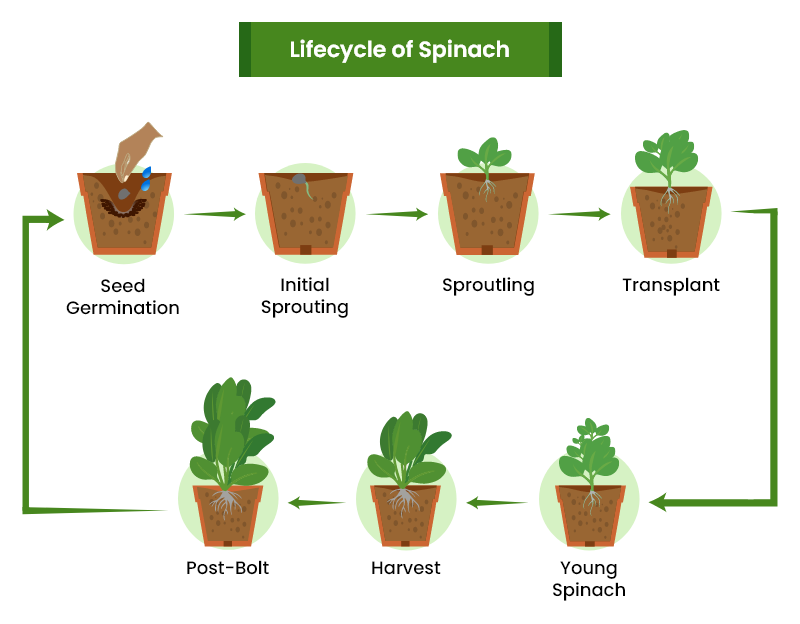
1. Seed germination
Spinach seeds don’t require special treatment like cold stratification. And they germinate in cool soil temperatures (of at least 40°F), which is why you can plant them early in spring.
2. Seedling
When a spinach plant first emerges, it starts with a pair of initial leaves called cotyledons. These leaves provide the plant with the required energy to grow.
As the seedling grows and develops more leaves, cotyledons start to wither or turn yellow. This seedling stage is short and takes around seven days or so.
3. Vegetative growth
When spinach moves past the seedling stage, it focuses on growing large and producing more leaves. As the plant matures, new big and heavy leaves appear.
Vegetative growth lasts 28-42 days. At the end of this period, spinach is expected to be ready for harvest. People harvest spinach at the end of this stage, cutting short its natural growth cycle.
4. Flowering
This stage lasts between 14 and 21 days. Spinach starts flowering due to environmental changes rather than a specific number of days after planting.
Some varieties of spinach start to bloom when they get 10-14 hours of sunlight and temperatures above 75°F every day.
5. Pollination
Spinach flowers don’t attract pollinators. Wind plays a vital role in pollinating plants by carrying pollen from one plant to another nearby plant.
Cross-pollination can happen between different spinach varieties. For gardeners interested in saving seeds for the following growing season, it is essential to keep various varieties separated.
6. Seed collection
Let your spinach plants flower to save seeds. When pollination happens, you will observe clusters of seeds popping up along the main stem. Seeds start forming as soon as 60 days after planting, depending on how warm it is.
You should pull up the plant when the seeds become tan and dry. Allow the seeds to dry for 10 days before storing them for future use.
How to Harvest Spinach?
- Spinach is ready to harvest in 6-10 weeks after sowing.
- When the leaves are about 6 inches long, you can harvest them.
- Cut back to just above the base of the plant to encourage more leaves to grow for a second crop.
- Harvest spinach by removing the outer leaves and allowing the center leaves to grow larger.
- It will enable the plant to keep producing new leaves.
- By picking the outer leaves, you can delay bolting.
- When plants are about to bolt in spring, you should immediately pull the entire plant to enjoy the leaves before they turn bitter.
How to Store Spinach?
- Before storing spinach, sort the bunch and remove yellow or brown discolored leaves. Discard damaged leaves.
- Store fresh unwashed spinach and wash it only when you want to use it.
- Store spinach in the crisper drawer of the fridge for about 2 days.
- The ideal storage temperature for spinach is 0 to 1°C. (for both leaves and roots)
- If you are not storing spinach in an airtight container, don’t keep it near ethylene-producing fruits.
- Store fresh spinach wrapped in a damp tea towel.
- To preserve spinach for a long time, you can freeze or blanch it.
Steps To Store Spinach:
- Lay dry paper towels at the bottom of your container.
- Layer fresh and dry spinach in the container on the paper towel.
- Close the lid and store the container in the refrigerator.
- Change the paper towel as and when required.
Best Spinach Varieties
1. Bloomsdale Long Standing
This has been a popular option for many reasons. Its thick, meaty leaves have a rich and nutty flavor. This spinach variety is excellent for cooking and freezing. This heavily savored type takes longer than most varieties to mature, at 30-50 days.
It can tolerate extreme heat. This heirloom variety thrives well in the garden. It is known for its long-standing quality even when the temperature climbs in late spring and early summer.
2. Palco
This quick-maturing savoy spinach takes only 38 days to mature. This spinach variety is resistant to bolting, mildew, and heat. You can plant this disease-resistant variety even in warmer seasons.
This hybrid variety is excellent for beginners and seasoned spinach growers alike. It is easy to grow and has a rich flavor. It has semi-savoyed leaves with an upright growth habit.
3. Giant Noble
This spinach variety grows into an extremely large plant with 25-inch-long smooth leaves and an overall spreading habit. It is slow to bolt and is perfect for cooking, steaming, or canning. Its dark green leaves are thick, broad, and pliable.
Its smooth leaves are suitable for fresh eating, making it versatile spinach. It can be grown over winter. You can harvest this variety in 35 days, but if you wait 50 days, you can enjoy full-sized leaves.
Common Pests and Diseases Problems with Spinach
Although spinach is easy to grow, it can face some common pests and disease issues. Pests like aphids, leaf miners, flea beetles, and caterpillars can affect the growth of spinach. Diseases that can affect the growth of spinach are downy mildew, powdery mildew, root rot, and fusarium wilt.
Regular inspection and prompt action can prevent and manage pests and disease problems in spinach crops.
Companion Plants for Spinach

Companion planting involves growing different plant species to enhance the main crop’s growth. It creates resilient agro-eco systems that can withstand the threat of diseases, pests, and harsh weather conditions.
Borage, cilantro, radish, legumes, nasturtiums, marigolds, tansy, strawberries, leafy greens, garlic, leeks, tomatoes, and kale can be grown alongside spinach.

